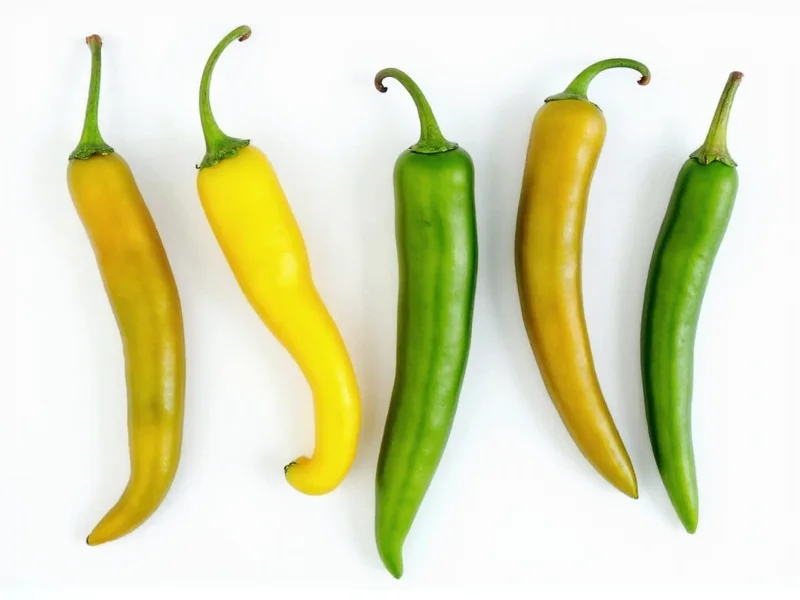When comparing serrano peppers vs jalapeño, understanding their distinct characteristics helps home cooks and culinary professionals make informed decisions for recipes. Both belong to the Capsicum annuum species but exhibit notable differences in heat, flavor, and culinary applications that significantly impact dish outcomes.
Heat Level Comparison: Understanding the Scoville Scale Differences
The most significant difference between serrano peppers vs jalapeño lies in their heat intensity. Serranos consistently rank hotter on the Scoville Heat Unit (SHU) scale, typically measuring between 10,000-23,000 SHU. In contrast, jalapeños range from 2,500-8,000 SHU, making them approximately 2-4 times milder than serranos.
This heat disparity means that substituting one for the other without adjustment can dramatically alter a dish's spiciness. When exploring serrano peppers vs jalapeno heat comparison for recipe development, consider that one serrano often equals 2-3 jalapeños in terms of heat contribution. The heat concentration also differs—serranos distribute capsaicin more evenly throughout the flesh, while jalapeños concentrate more heat in the seeds and membranes.
| Pepper Type | Scoville Heat Units | Relative Heat Level | Heat Distribution |
|---|---|---|---|
| Serrano Pepper | 10,000-23,000 SHU | High | Evenly distributed throughout flesh |
| Jalapeño Pepper | 2,500-8,000 SHU | Medium | Concentrated in seeds/membranes |
Physical Characteristics and Appearance
Visually distinguishing serrano peppers vs jalapeño is straightforward. Serranos measure 1-3 inches long with a smooth, glossy exterior and typically grow upright on the plant. They transition from bright green to red, orange, or yellow when mature. Their shape is consistently conical with thin walls (1-2mm).
Jalapeños grow larger (2-4 inches), often developing characteristic wrinkles as they mature, especially when left on the plant longer. They hang downward and have noticeably thicker walls (3-5mm), making them better suited for stuffing applications. The difference between serrano and jalapeno peppers in appearance directly impacts their culinary uses—thinner-walled serranos work better in fresh preparations while thicker jalapeños hold up to cooking methods.
Flavor Profiles and Culinary Applications
Beyond heat, the flavor profiles of serrano peppers vs jalapeño reveal important distinctions for recipe development. Serranos deliver a bright, grassy, almost herbal flavor with citrus undertones that remains consistent whether raw or cooked. This makes them exceptional in fresh salsas, pico de gallo, and ceviche where their clean heat shines.
Jalapeños offer a more complex flavor profile with earthier, slightly sweet notes that develop roasted, smoky characteristics when cooked. Their thicker walls make them ideal for stuffing (think jalapeño poppers), pickling, and roasting. When considering serrano vs jalapeno for salsa, serranos provide cleaner heat in raw preparations while jalapeños contribute more body and depth in cooked salsas.
Chefs evaluating serrano peppers vs jalapeno usage should note that serranos maintain their heat better when cooked, while jalapeños mellow significantly. This makes serranos preferable for long-simmered sauces where consistent heat is desired.
Substitution Guidance and Recipe Adaptation
Understanding can I substitute serrano for jalapeno is crucial for successful recipe adaptation. When replacing jalapeños with serranos, use approximately half the quantity to maintain similar heat levels. Conversely, when substituting jalapeños for serranos, you may need 2-3 times the amount to achieve comparable spiciness.
For raw applications like fresh salsas or guacamole, serranos provide a cleaner, brighter heat that doesn't overwhelm other ingredients. In cooked dishes like stews or braises, jalapeños' thicker walls and earthier flavor often integrate more seamlessly. The serrano pepper substitutes for jalapeno work best in applications where pronounced heat is desired without significant flavor alteration.
When working with either pepper, remember that heat concentration varies within the same variety—smaller peppers of the same type often pack more heat. Always taste a small piece before committing to a recipe, especially when exploring serrano peppers vs jalapeno heat comparison in practice.
Nutritional Comparison and Storage Tips
Both peppers offer similar nutritional benefits as members of the capsicum family, rich in vitamin C, vitamin A, and capsaicin with its associated metabolic benefits. The serrano peppers vs jalapeno nutritional value comparison shows negligible differences in macronutrients, though serranos contain slightly higher concentrations of capsaicinoids due to their greater heat.
For storage, both peppers maintain freshness for 1-2 weeks in the refrigerator's crisper drawer. Serranos, with their thinner walls, may deteriorate slightly faster than jalapeños. For longer preservation, both freeze well after roasting or can be dried for future use. When comparing serrano vs jalapeno storage, note that jalapeños' thicker walls make them slightly more resilient to moisture loss during refrigeration.
Practical Applications in Everyday Cooking
Understanding the difference between serrano and jalapeno peppers helps optimize their use in specific culinary contexts. Serranos excel in:
- Fresh green salsas where clean heat is desired
- Ceviche and raw seafood preparations
- Vinegar-based hot sauces requiring consistent heat
- Garnishes where visual appeal matters (smooth skin)
Jalapeños shine in:
- Stuffed preparations (popper, cream cheese fillings)
- Pickled applications (sport peppers, jalapeño rings)
- Smoked form (chipotles in adobo sauce)
- Cooked salsas and stews where mellow heat is preferred











 浙公网安备
33010002000092号
浙公网安备
33010002000092号 浙B2-20120091-4
浙B2-20120091-4